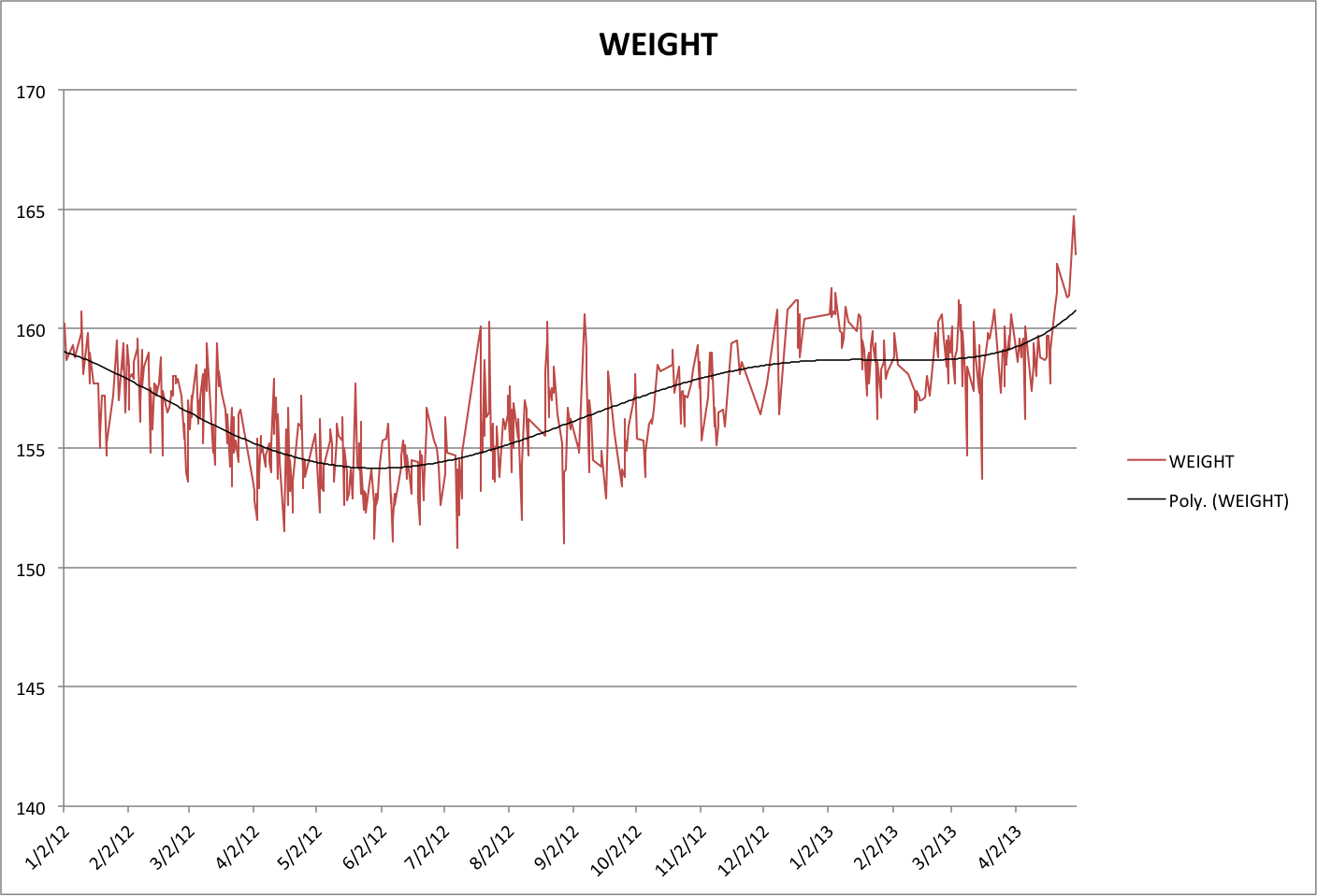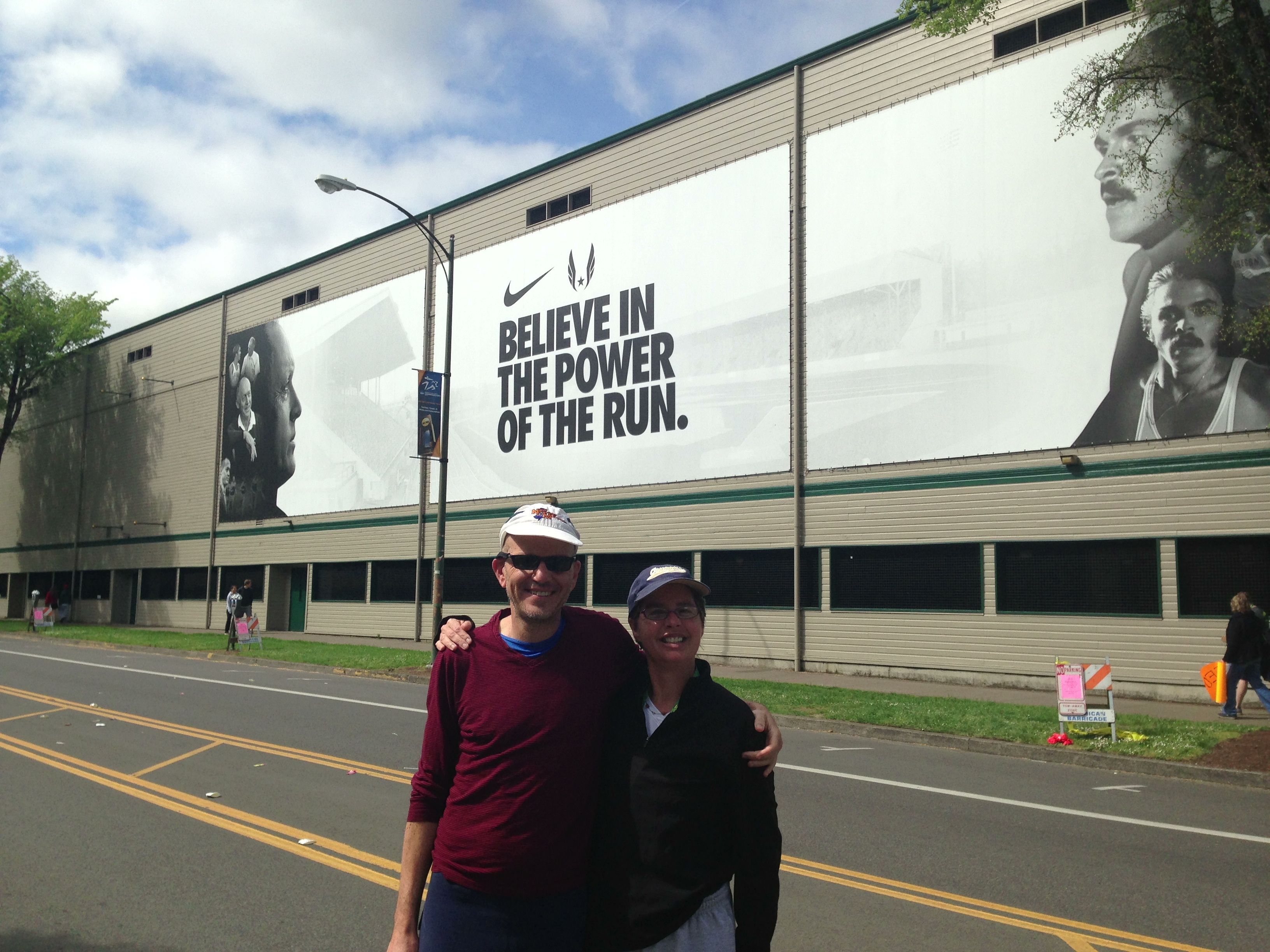Number 32 was the 2013 Eugene Marathon.
I finished in 3:21:01, 362 of 2564 marathon finishers, 284 of 1342
in men and 24 of 125 in my age group. I ran a fantastic race
through 20 miles, things went down hill from there. Apparently a
few gel packs (4) along the way are not enough to vault over the
wall. The table below summarizes the gory details. While I am
naturally disappointed that I fell apart in the last few miles, I
am pleased to know that I can run 20 miles at 7 minute pace. It
should not be impossible to extend that limit to 26.2. The first
half was the second fastest half marathon I have ever run, bested
only by the 1:27:03
in New Bern. While one can certainly observe that I went out
too fast, I think that sustained intensity is the only hope for a
fast time.
Distance
|
Time
|
Pace
|
5 K
|
20:31
|
6:36
|
10 K
|
41:02
|
6:37
|
Half
|
1:29:10
|
6:49
|
20 Mile
|
2:20:18
|
7:01
|
Finish
|
3:21:01
|
7:40
|
I have a lot of experience going out too fast and
collapsing, see races 1,
2,
4,
5
I did not fall apart in races 3,
and most memorably, 10,
however. Since 10 I have mostly played the kick back seasoned
runner with no real interest in winning. Winning came to me,
however, in the past couple of years as I suddenly set new PRs in
the 5k and half. Run 28 was a low point in the project to date, as
I struggled to come in under 4 hours and finished with spasmonic
legs and universal pain. Leaving complacency behind and training
more seriously for the past few runs has led to serious results. I
went out fast unconsciously in run 30,
and thus was not surprised by or regretful of the collapse. I went
out fast deliberately in 32 and am disappointed by the result.
This is the third fastest of 32, however, narrowly edging out New
York and Washington.
It's interesting to be at the point where 3rd is a bitter
disappointment. Here is the pace and elevation chart for Eugene:
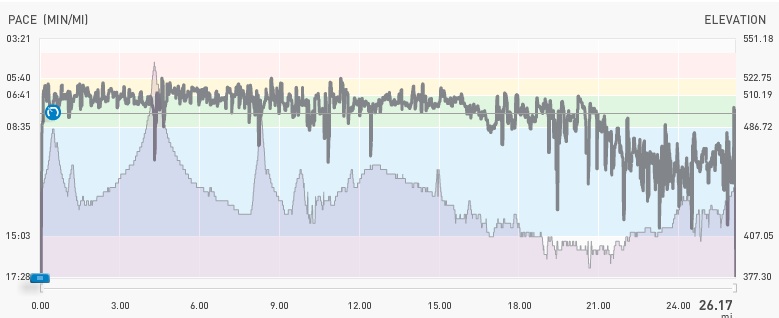
For those interested in the technical details, I
think that my failure to finish strong was due to three factors:
- My training volume and intensity were insufficient and
- My weight was too high.
- My cross training and strength conditioning were insufficient
In my 2002
PR run, I remember that training volume reached above 65 miles
per week. I don't have precise training records (or if I do they are
lost in a paper notebook in a closet somewhere), but I know that I
followed advice from Advanced
Marathoning. This being the modern age, this year I trained
using Adias MiCoach. Here is my training volume in 2012 leading up
to Kentucky
on June 9.
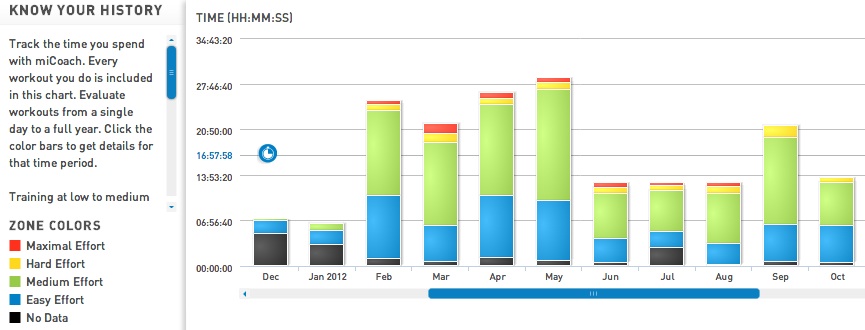
Wow, May had some seriously green content. Assuming 9 minute average
training pace, May corresponded to 41 miles/week. Even at 8 minute
pace, it is only 47 miles per week. While not all runs were recorded
on miCoach, training volume for the Oregon marathon was
conspiciously worse:
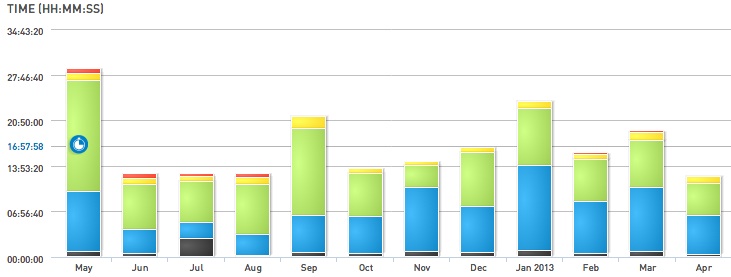
My weight tracked training, leading to a low mass not seen since
probably 9th grade on the day of the Kentucky race and balloon
weight leading into and after Oregon:
I wanted to loose weight going to Oregon and resolved in January to
come back down to the Kentucky weight or better. Other plans got in
the way. Most likely, both increased training volume and abstention
from alcohol will be necessary to limit the load I carry.
I ran Kentucky, Nevada and Oregon in Merrell true glove shoes, a
wide trail version for Nevada and Oregon. While I love minialist
running, I have not been able to descend stairs without pain in my
left ankle for over a year. I also felt some sharp calf pains in the
last few miles in Oregon. The knowledge that I am never completely
healthy and the fear that I could get serious injuries looms over a
plan for a faster marathon....
Loyal readers will recall that preliminary experiments with
minialist shoes ended in disaster.
I have, however, been completely converted for the last year and a
half. However, the recent text Tread
Lightly suggests that a diversity of running shoes, even
better a diversity of training, may help strengthen diverse muscle
groups and prevent injury. I propose therefore to broaden the range
of shoes used and to increase non-running activity in the next
round.
One tough question arises: perhaps I am not tough enough to go the
distance. Maybe I should have run harder through the pain. I don't
think that this is the case, but I am not in as much agony a day
after the race as I have sometimes been. Perhaps I need to go when
my legs say stop. We will see next time.
I must confess that I was a bit depressed at the end of this race. I
have PR'ed at every distance short of the marathon in the past year,
why must the big dance be so different. I have thought ever since I did
the Boston thing that marathon times were not important. It is
definitely not healthy to race in marathons. And yet, why not me,
why not now? I thought, as I finished the race, that I should
remember that I do not race marathons and I should finish the
project simply. Speed was not in the design specification for this
project. And yet, I ran 20 miles at 7 minute pace! Today I fight on,
dear reader! I tell you now, though I should make you wait on
events, that I will try to fix points 1-3. Though I am not
as young as I once was, I am not dead yet.
Of course, if I were primarily a runner life might be different. I
have a job, I have a girl, I have something going Mr. in this
world. ( A song which is pretty depressing but not as
depressing as this one.)
I can't devote full time to training, I have other things to do. On
the other hand, all we are talking about is 3 hours per week. If I
go from 7 hours training per week to 10 hours, maybe I will pass
this arbitrary barrier of no interest to any one but me. 26.2
instead of 20. 3 hours instead of 3 hours 13 minutes.
Speaking of my job, watch friends for Aqueti and the Kickstarter
launch. It is a busy time, giving some modest alibi for the lack of
training volume.
Speaking of my girl, Rachael joined me in Eugene. She ran the half,
with no training, in 2:16: 17, 2543 of 4079 finishers, 1424 of 2626
among the fillies, 84 of 207 in her age group. Rachael and I used a
ginormous amount of frequent flier miles to fly first class to
Portland, because if we are not able to fly first class at our age
when will we? I use gionormous advisedly, because I have discouraged
Rachael from using this non-word but we heard it repeatedly used in
Oregon.
Speaking of Oregon, it is traditional in a report such as this to
say something of the venue and the crowd. In the words of jealousy,
Oregon is the homogeneous home of boring vegitarian anti-growth self
satisfied hermits. Stand up and pump some gas! The run begins and
ends at legendary Hayward field, almost as amazing at finishing in Notre
Dame stadium or finishing
with a football. Here is a picture at start, before I knew I
my doom, at the entrance to Hayward:
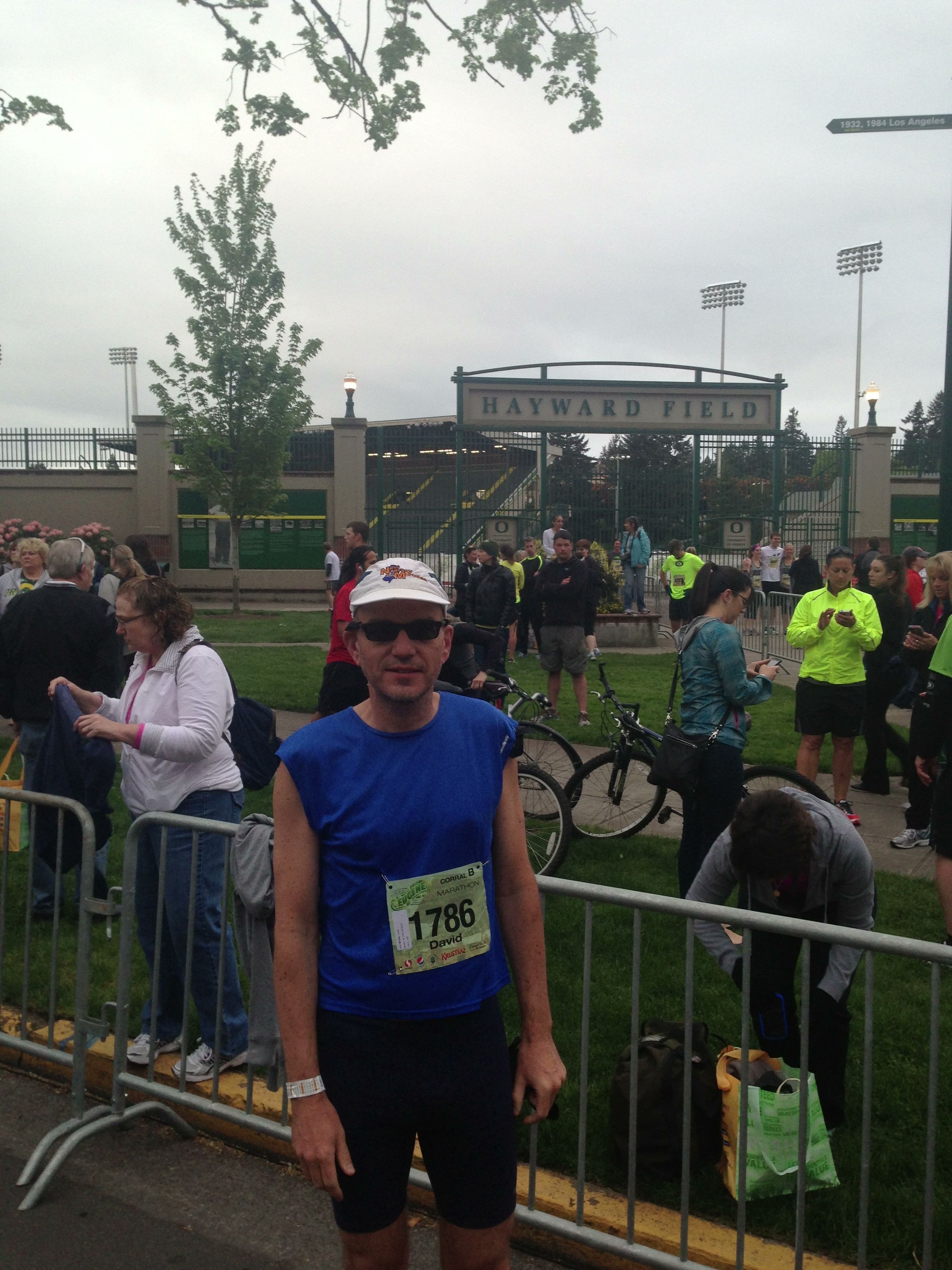
Later, I finished on the track looking like
this:
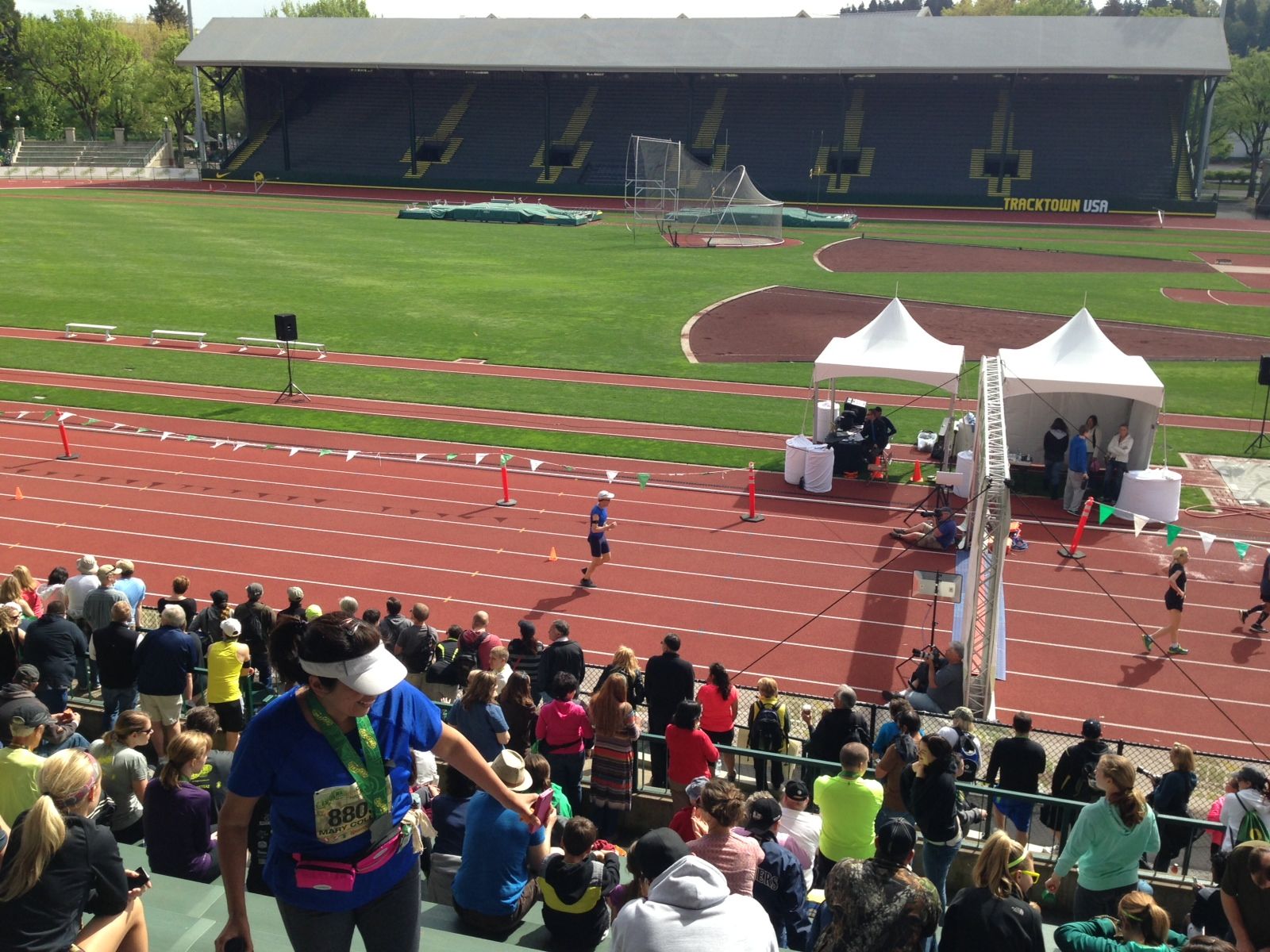
Rachael and I then walked past the legends of Hayward on our
way to the shuttle bus
Despite all this, track town USA is more than a bit sad. The "O" is
O-ppressive, the University is not quite something that the track
team can be proud of and the state is a bit too far from everywhere.
We loved seeing old friends in Portland!, but in our
minds we were going to Carolina. The run along the Willamette
is beautiful, but the path is paved in painful concrete. When 51
contestants race, only one can win. Both the James
and the Potomac
are nicer river runs, Oregon
weighs in at a respectable 21 among the 32 yet done.







